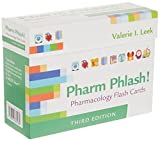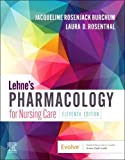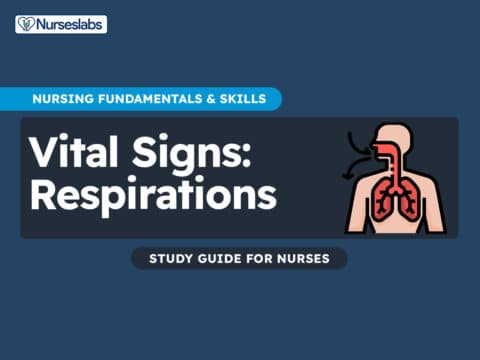Expectorants are drugs that liquefy the lower respiratory tract secretions. They are used for the symptomatic relief of respiratory conditions characterized by a dry, nonproductive cough.
Mucolytics work to break down mucus to aid high-risk respiratory patients in coughing up thick, tenacious secretions.
Learn about the uses and nursing care plan considerations needed for patients taking expectorants and mucolytics in this nursing pharmacology study guide.
Expectorants and Mucolytics: Generic and Brand Names
Here is a table of commonly encountered expectorant and mucolytics, their generic names, and brand names:
- Expectorants
- guaifenesin (Mucinex)
- Mucolytic
- acetylcysteine (Mucomyst)
- dornase alfa (Pulmozyme)
Disease Spotlight: Chronic Obstructive Pulmonary Disease
Chronic obstructive pulmonary disease (COPD) is a permanent, chronic obstruction of the airways, often related to cigarette smoking.
- COPD is caused by two related disorders- emphysema and chronic bronchitis– both of which result in airflow obstruction on expiration, as well as overinflation of the lungs and poor gas exchange.
- Emphysema is characterized by loss of the elastic tissue of the lungs, destruction of alveolar walls, and resultant alveolar hyperinflation with a tendency to collapse with expiration.
- Chronic bronchitis is a permanent inflammation of the airways with mucus secretion, edema, and post inflammatory defenses.
Expectorants
What are Expectorants?
Expectorants increase productive cough to clear the airways.
- They liquefy lower respiratory tract secretions, reducing the viscosity of these secretions and making it easier to cough them up.
- Expectorants are available in many OTC preparations, making them widely available to the patient without advice from a health care provider.
Therapeutic actions
The desired actions of expectorants include:
- Enhances the output of respiratory tract fluids by reducing the adhesiveness and surface tension of these fluids, allowing easier movement of the less viscous secretions.
Indications of Expectorants and Mucolytics
Expectorants are indicated for the following:
- Symptomatic relief of respiratory conditions characterized by a dry, nonproductive cough.
Pharmacokinetics
Guaifenesin is rapidly absorbed, with an onset of 30 minutes and a duration of 4 to 6 hours.
| Route | Onset | Peak | Duration |
|---|---|---|---|
| Oral | 30 min | Unknown | 4-6h |
| Half-life (T1/2) | Metabolism | Excretion |
|---|---|---|
| Unknown | Unknown | Unknown |
Contraindications and Cautions
The following are contraindications and cautions when using expectorants:
- Allergy. This drug should not be used in patients with a known allergy to the drug to prevent hypersensitivity reactions.
- Pregnancy or lactation. This drug should be used with caution in pregnancy and lactation because of the potential adverse effects on the fetus or baby.
- Cough. This drug should not be used with persistent coughs, which could be indicative of an underlying medical problem.
Adverse effects
Adverse effects from the use of expectorants:
- GI: Nausea, vomiting, anorexia.
- CNS: Headache, dizziness.
- Underlying cough: The most important consideration in the use of these drugs is discovering the cause of the underlying cough; prolonged use of the OTC preparations could result in the masking of important symptoms of a serious underlying disorder.
- Respiratory: Rhinorrhea, bronchospasm.
- Skin: Rash.
Mucolytics
What are mucolytics?
Mucolytics increase or liquefy respiratory secretions to aid the clearing of the airways in high-risk respiratory patients who are coughing up thick, tenacious secretions.
- Patients may be suffering from conditions such as chronic obstructive pulmonary disease (COPD), cystic fibrosis, pneumonia, or tuberculosis.
Therapeutic Actions
The desired actions of mucolytics include:
- Protect liver cells from being damaged during episodes of acetaminophen toxicity because it normalizes hepatic glutathione levels and binds with a reactive hepatotoxic metabolite of acetaminophen.
- Affects the mucoproteins in the respiratory secretions by splitting apart disulfide bonds that are responsible for holding the mucus material together.
- The result is a decrease in the tenacity and viscosity of the secretions.
- Dornase alfa is a mucolytic prepared by recombinant DNA techniques that selectively break down respiratory tract mucus by separating extracellular DNA from proteins.
Indications
Mucolytics are indicated for the following:
- Liquefaction of secretions in high-risk respiratory patients who have difficulty moving secretions including postoperative patients (e.g., patients with tracheostomies to facilitate airway clearance and suctioning).
- Clearing of secretions for diagnostic tests (e.g., diagnostic bronchoscopy).
- Used orally to protect the liver from acetaminophen toxicity.
- Treatment of atelectasis from thick mucus secretions.
Pharmacokinetics
Mucolytics may be administered by nebulization or by direct instillation into the trachea via an endotracheal tube or tracheostomy.
| Route | Onset | Peak | Duration |
|---|---|---|---|
| Instilation inhalation | 1 min | 5-10 min | 2-3h |
| Oral | 30-60 min | 1-2h | Unknown |
Contraindications and Cautions
The following are contraindications and cautions when using mucolytics:
- Medical conditions. Caution should be used in cases of acute bronchospasms, peptic ulcer, and esophageal varices because the increased secretions could aggravate the problem.
Adverse Effects
Adverse effects from the use of expectorants and mucolytics include the following:
- GI: Nausea, vomiting, anorexia.
- CNS: Headache, dizziness.
- Underlying cough: The most important consideration in the use of these drugs is discovering the cause of the underlying cough; prolonged use of the OTC preparations could result in the masking of important symptoms of a serious underlying disorder.
- Respiratory: Rhinorrhea, bronchospasm.
- Skin: Rash.
Nursing Considerations for Expectorants and Mucolytics
Nursing considerations when using expectorants and mucolytics include the following:
Nursing Assessment
History taking and physical examination of a patient using expectorants and mucolytics include:
- Assess for possible contraindications and cautions: any history of allergy to the drug; persistent cough due to smoking, asthma, or emphysema, which would be cautions to the use of the drug; and very productive cough, which would indicate an underlying problem that should be evaluated.
- Perform a physical examination to establish baseline data for assessing the effectiveness of the drug and the occurrence of any adverse effects associated with the drug therapy.
- Assess the skin for the presence of lesions and color to monitor for any adverse reactions.
- Monitor temperature to assess for underlying infection.
- Assess respirations and adventitious sounds to evaluate the respiratory response to the drug effects.
- Monitor orientation and affect to monitor CNS effects of the drug.
- Monitor blood pressure and pulse to evaluate cardiac response to drug treatment.
Nursing Diagnosis and Care Planning
Nursing diagnoses related to the use of expectorants or mucolytics are:
- Acute pain related to GI, CNS, or skin effects of the drug.
- Disturbed sensory perception (Kinesthetic) related to CNS effects.
- Deficient knowledge regarding drug therapy.
- Ineffective airway clearance related to bronchospasm.
Nursing Implementation with Rationale
The nursing interventions for patients using expectorants include:
- Proper administration. Caution the patient not to use these drugs for longer than 1 week and to seek medical attention if the cough persists after that time to evaluate for any underlying medical condition and to arrange for appropriate treatment.
- Prevent GI upset. Advise the patient to take small, frequent meals to alleviate some of the GI discomfort associated with these drugs.
- Ensure safety. Advise the patient to avoid driving or performing dangerous tasks if dizziness and drowsiness occur to prevent patient injury.
- Avoid overdosage. Alert the patient that these drugs may be found in OTC preparations and that care should be taken to avoid excessive doses.
- Provide health education. Provide thorough patient teaching, including the drug name and prescribed dosage, measures to help avoid adverse effects, warning signs that may indicate problems, and the need for periodic monitoring and evaluation, to enhance patient knowledge about drug therapy and to promote compliance.
- Offer support. Offer support and encouragement to help the patient cope with the disease and with the drug regimen.
Nursing interventions for patients using mucolytics include:
- Ensure drug effectiveness. Avoid combining other drugs in the nebulizer to avoid the formation of precipitates and potential loss of effectiveness of either drug.
- Proper drug delivery. Dilute concentrate with sterile water for injection if buildup becomes a problem that could impede drug delivery.
- Prevent skin breakdown. Note that patients receiving acetylcysteine by face mask should have the residue wiped off the face mask and off the face with plain water to avoid skin breakdown.
- Proper use of nebulizer. Review use of the nebulizer with patients receiving dornase alfa at home to ensure the most effective use of the drug.
- Proper storage. Patients should be cautioned to store the drug in the refrigerator, protected from light.
- Dornase alfa use. Caution cystic fibrosis patients receiving dornase alfa about the need to continue all therapies for their cystic fibrosis because dornase alfa is only a palliative therapy that improves respiratory symptoms, and other therapies are still needed.
- Provide health education. Provide thorough patient teaching, including the drug name and prescribed dosage, measures to help avoid adverse effects, warning signs that may indicate problems, and the need for periodic monitoring and evaluation, to enhance patient knowledge about drug therapy and to promote compliance.
- Provide support. Offer support and encouragement to help the patient cope with the disease and with the drug regimen
Evaluation
Evaluation of a patient using expectorants and mucolytics include the following:
- Monitor patient response to the drug (improved effectiveness of cough).
- Monitor for adverse effects (skin rash, GI upset, bronchospasm, CNS effects).
- Evaluate the effectiveness of the teaching plan (patient can name drug, dosage, adverse effects to watch for, specific measures to avoid them, and measures to take to increase the effectiveness of the drug).
- Monitor the effectiveness of comfort and safety measures and compliance with the regimen.
Recommended Resources
Our recommended nursing pharmacology resources and books:
Disclosure: Included below are affiliate links from Amazon at no additional cost from you. We may earn a small commission from your purchase which will help support us. Thank you! For more information, check out our privacy policy.
Pharm Phlash! Pharmacology Flash Cards #1 BEST SELLER!
Test-yourself review cards put critical clinical information for nearly 400 of the top generic medications at your fingertips. And, you can count on them for accuracy, because each card is based on content from Davis’s Drug Guide for Nurses. Increase your test scores in pharmacology class.

Focus on Pharmacology (8th Edition)
Focus on Nursing Pharmacology makes challenging concepts more approachable. Engaging learning features cultivate your clinical application, critical thinking and patient education capabilities. This updated 8th edition builds on your knowledge of physiology, chemistry and nursing fundamentals to help you conceptualize need-to-know information about each group of drugs.

Pharmacology Made Incredibly Easy (Incredibly Easy! Series®)
Nursing pharmacology guide offers step-by-step guidance so you can grasp the fundamentals in enjoyable Incredibly Easy style. This is the perfect supplement to class materials, offering solid preparation for NCLEX® as well as a handy refresher for experienced nurses. Colorfully illustrated chapters offer clear, concise descriptions of crucial nursing pharmacology concepts and procedures.

Lehne’s Pharmacology for Nursing Care (11th Edition)
The Eleventh Edition of Lehne’s Pharmacology for Nursing Care provides a thorough understanding of key drugs and their implications for nursing care. This text, written by renowned nursing educators, helps you comprehend and apply pharmacology principles. A clear and engaging writing style simplifies complex concepts, making even the most challenging pharmacology content enjoyable. We recommend this book if you want a comprehensive nursing pharmacology guide.

Nursing Drug Handbook
Nursing2023 Drug Handbook delivers evidence-based, nursing-focused drug monographs for nearly 3700 generic, brand-name, and combination drugs. With a tabbed, alphabetical organization and a “New Drugs” section, NDH2023 makes it easy to check drug facts on the spot.

Pharmacology and the Nursing Process
The 10th edition of Pharmacology and the Nursing Process offers practical, user-friendly pharmacology information. The photo atlas contains over 100 unique illustrations and photographs depicting drug administration techniques. Updated drug content reflects the most recent FDA drug approvals, withdrawals, and therapeutic uses.

Mosby’s Pharmacology Memory NoteCards: Visual, Mnemonic, and Memory Aids for Nurses
The 6th edition of Mosby’s Pharmacology Memory NoteCards: Visual, Mnemonic, & Memory Aids for Nurses incorporates illustrations and humor to make studying easier and more enjoyable. This unique pharmacology review can be utilized as a spiral-bound notebook or as individual flashcards, making it ideal for mobile study.

See Also
Here are other nursing pharmacology study guides:
- Nursing Pharmacology – Study Guide for Nurses
Our collection of topics related to nursing pharmacology - Pharmacology Nursing Mnemonics & Tips
These nursing mnemonics aim to simplify the concepts of pharmacology through the use of a simple, concise guide. - Generic Drug Name Stems Cheat Sheet
Learn about these generic drug name stems to help you make sense of drugs easier! - Common Drugs and Their Antidotes
A guide to drug antidotes that nurses should be familiar about. - IV Fluids and Solutions Guide & Cheat Sheet
Get to know the different types of intravenous solutions or IV fluids in this guide and cheat sheet. - Drug Dosage Calculations NCLEX Practice Questions (100+ Items)
Care to take the challenge? This quiz aims to help students and registered nurses alike grasp and master the concepts of medication calculation.
We have a pill for that…
Drug Guides NEW!
Individual drug guides and nursing considerations for the most common medications used in nursing pharmacology:
- Acetaminophen (Tylenol)
- Aspirin
- Atorvastatin (Lipitor)
- Enoxaparin (Lovenox)
- Furosemide (Lasix)
- Gabapentin
- Hydromorphone (Dilaudid)
- Lisinopril
- Metoprolol
- Morphine
Gastrointestinal System Drugs
Respiratory System Drugs
- Antihistamines
- Bronchodilators and Antiasthmatics
- Decongestants
- Expectorants and Mucolytics
- Inhaled Steroids
- Lung Surfactants
Endocrine System Drugs
- Adrenocortical Agents
- Antidiabetic Agents
- Glucose-Elevating Agents
- Hypothalamic Agents
- Insulin
- Parathyroid Agents: Bisphosphonates, Calcitonins
- Pituitary Drugs
- Sulfonylureas
- Thyroid Agents
Autonomic Nervous System Drugs
- Adrenergic Agonists (Sympathomimetics)
- Adrenergic Antagonists (Sympatholytics)
- Anticholinergics (Parasympatholytics)
- Cholinergic Agonists (Parasympathomimetics)
Immune System Drugs
Chemotherapeutic Agents
- Anthelmintics
- Anti-Infective Drugs
- Antibiotics
- Antifungals
- Antineoplastic Agents
- Antiprotozoal Drugs
- Antiviral Drugs
Reproductive System Drugs
Nervous System Drugs
- Antidepressants
- Antiparkinsonism Drugs
- Antiseizure Drugs
- Anxiolytics and Hypnotic Drugs
- General and Local Anesthetics
- Muscle Relaxants
- Narcotics, Narcotic Agonists, and Antimigraine Agents
- Neuromuscular Junction Blocking Agents
- Psychotherapeutic Drugs
Cardiovascular System Drugs
References and Sources
The following are the recommended supplemental reading for this expectorants and mucolytics nursing pharmacology study guide:
- Adams, M. P., & Urban, C. (2015). Pharmacology: Connection to Nursing. Pearson Education.
- Karch, A. M., & Karch. (2011). Focus on nursing pharmacology. Wolters Kluwer Health/Lippincott Williams & Wilkins. [Link]
- Katzung, B. G. (2017). Basic and clinical pharmacology. McGraw-Hill Education.
- Lehne, R. A., Moore, L. A., Crosby, L. J., & Hamilton, D. B. (2004). Pharmacology for nursing care.
- Smeltzer, S. C., & Bare, B. G. (1992). Brunner & Suddarth’s textbook of medical-surgical nursing. Philadelphia: JB Lippincott.






































Leave a Comment